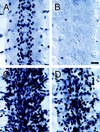Isolation and characterization of mammalian homologs of the Drosophila gene glial cells missing
- PMID: 9770492
- PMCID: PMC22837
- DOI: 10.1073/pnas.95.21.12364
Isolation and characterization of mammalian homologs of the Drosophila gene glial cells missing
Abstract
The glial cells missing (gcm) gene in Drosophila encodes a transcription factor that determines the choice between glial and neuronal fates. We report here the isolation of two mammalian gcm homologs, Gcm1 and Gcm2, and the characterization of their expression patterns during embryonic development. Although Gcm2 is expressed in neural tissues at a low level, the major sites of expression for both of the mammalian genes are nonneural, suggesting that the functions of the mammalian homologs have diverged and diversified. However, when expressed ectopically, Gcm1 can substitute functionally for Drosophila gcm by transforming presumptive neurons into glia. Thus, certain biochemical properties, although not the specificity of the tissue in which the gene is expressed, have been conserved through the evolution of the Gcm gene family.
Figures





References
Publication types
MeSH terms
Substances
Associated data
- Actions
- Actions
- Actions
LinkOut - more resources
Full Text Sources
Other Literature Sources
Molecular Biology Databases

